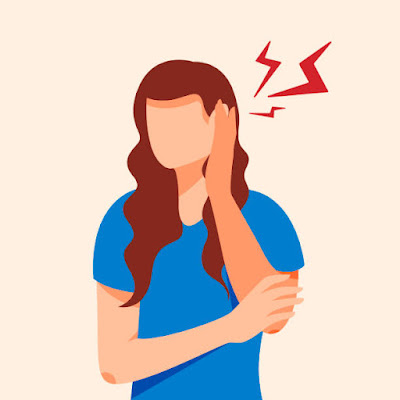Trigeminal Neuralgia - Symptoms and Signs
 |
| Trigeminal Neuralgia |
According to Baughman (2000), the clinical manifestations that appear in cases of trigeminal neuralgia are as follows:
- Pain is felt in the skin, not in deeper structures, more severe in the peripheral areas of the distribution of the affected nerves, namely the lips, chin, nostrils, and teeth.
- Paroxysm is stimulated by stimulation of the terminals of the affected nerve branches, namely washing the face, shaving, brushing teeth, eating and drinking.
- Cold airflow and direct pressure on the trunk nerves can also cause pain. This occurs because the flow of cold air hits the trigger area or pain area in the branching part of the trigeminal nerve (fifth cranial nerve). Cold air flow includes non-noxious stimuli (stimulus in the form of light touch, vibration or chewing stimulus).
- The trigger point is the definite area where the lightest touch immediately triggers paroxysm.
Trigeminal neuralgia gives symptoms and signs as follows: (Ossen, 1988; Passon, 2001; Sharav, 2002; Brice, 2004)
- The pain is in the form of neuropathic pain, namely paroxysmal severe pain, sharp, such as stabbing, shooting, electric shock, lightning, or burning that lasts for a few seconds to a few minutes but less than two minutes, suddenly and repeatedly. Between attacks there is usually a pain-free interval, or there is only mild dullness.
- The location of the pain is generally limited to the dermatome of the trigeminal nerve and is characterized by unilateral pain. The most common pain is in the area of distribution of the mandibular nerve (V2) 19.1% and the maxillary nerve (V3) 14.1% or a combination of both 35.9% so that the most frequent pain is pain. on the lower half of the face. Rarely limited to the ophthalmic nerve (V3) 3.3%. Some patients felt pain in all branches of the trigeminal nerve (15.5%) or a combination of the maxillary and ophthalmic nerves (11.5%). Rarely found a combination of pain in the distribution area of the ophthalmic and mandibular nerves (0.6%). Bilateral pain 3.4%, pain is rarely felt on both sides at the same time, generally between the two sides separated by several years. Bilateral cases are usually associated with multiple or familial sclerosis.
- Trigeminal neuralgia can be triggered by non-noxious stimuli such as light touch, vibration, or chewing stimuli. As a result, patients will experience difficulties or arise when brushing their teeth, eating, swallowing, talking, shaving their faces, touching their faces, washing their faces and even blowing cold winds. Usually the trigger area is on the front of the face, with pain in the same trigeminal nerve branching area. If the trigger area is in the scalp area, the patient is afraid to wash or comb.
- Pain in trigeminal neuralgia may go into remission within a year or so. In the active period of neuralgia, there is a characteristic increase in the frequency and severity of pain attacks progressively over time.
- About 18% of patients with trigeminal neuralgia, initially atypical pain that gradually becomes typical, is called trigeminal preneuralgia. A dull, constant pain in one jaw that lasts from a few days to several years. Thermal stimulation can cause throbbing pain so it is often considered dental pain. Administration of anticonvulsant therapy can relieve trigeminal preneuralgia pain so that this method can be used to distinguish the two pains.
- On physical examination and neurologic usually normal or no significant neurologic deficit found. Significant loss of sensibility to the trigeminal nerve leads to the search for an underlying pathological process, such as a tumor or infection that can damage the nerve. In the tumor in addition to atypical pain and loss of sensibility, accompanied by disturbances in other cranial nerves.